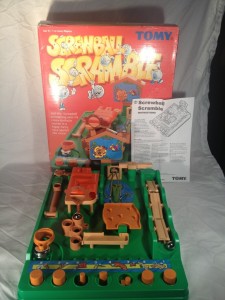 Tomy were responsible for many electronic games and toys in the 80s including the Tomytronics, Omnibot, Lights Alive and Super Cup Football. They were also quite good at games that didn’t require batteries.
Tomy were responsible for many electronic games and toys in the 80s including the Tomytronics, Omnibot, Lights Alive and Super Cup Football. They were also quite good at games that didn’t require batteries.
The aim of Screwball Scramble is to navigate a ball bearing around a course in the quickest time possible. You would put the ball at the bottom right, wind up the clockwork timer (yes, clockwork, how 20th century!), aaaanndddd……
GO!
Using the controls at the bottom you first had to roll the ball along a three section bridge. This required quite precise timing and use of momentum to get the ball to the end of this first obstacle. This section on its own could take an amateur Screwballer a good few minutes and often end in tears of frustration.
Then there was the “Rotating Thing” thing that transported the ball from the end of the bridge. This was, essentially, a magnet on a stick. Move it too quickly and your ball could whiz off the game, flung under neighbouring furniture to its certain doom. Move it too slowly and it wouldn’t have enough momentum to propel off at the end when it should do.
This took the ball to the third obstacle, the “Widenable Beams”. Again, this required quite precise fiddling. You had to widen the beams just enough to encourage the ball to roll downwards, but also have the timing to know when to close them and not allow the ball to fall out of play.
The ball then fell out onto a “Peg Maze” with two exits. One exit lead out to a ramp and one lead out to certain death.
Assuming you had made it out to the ramp the next obstacles were the “Jump Stumps.” They were stumps that you needed to hop your ball up. To navigate these, players had to tap the button at the bottom of the game with meticulous precision so as to not overshoot the following stump. There were 4 stumps in total followed by a hoop to jump through.
Then your poor ball headed into the “Maze of Precariousness”. (Yes, in case you were wondering, I am inventing all these obstacle names.) The Maze was a solid plastic block with no windows, no trap doors and no real way of knowing where your ball was. Players just wiggled the control stick in blind panic, sometimes for way over 30 seconds, often to not see the ball pop out of the end, but re-emerge at the entrance again.
Maze over, (eventually,) you had to rotate the ball, with a device shaped a little like a boat, to be in place for the final obstacle, the “Catapult of Cataclysm.” With your ball securely loaded in the Catapult, all you had to do was hit the final button for flip the catapult over and make your ball hit the final bell.
With that final DING, you could reach over and stop your clockwork timer.
In reality, the chances are that your timer had already run out a good few minutes ago. You just wanted to be able to claim you had finished one of the best games of the 80s.
















